Poseidon continues UN monitoring
C-130J first flight takes off
Our warbirds at Wānaka


Poseidon continues UN monitoring
C-130J first flight takes off
Our warbirds at Wānaka

Mechanic returns to school to inspire students
Air Force recruits back school’s values Maintenance in a foreign environment


OUR MISSION
The RNZAF will provide New Zealand with relevant, responsive and effective Air Power to meet its security interests.
OUR VISION
An agile and adaptive Air Force with the versatility essential for NZDF operations.


COVER: Mission to Solomon Islands
PHOTOGRAPHER: LAC Andy Jenkins

Published by Defence Public Affairs HQ NZ Defence Force Wellington, New Zealand
Editor Rebecca Quilliam Email: airforcenews@nzdf.mil.nz
Design and Layout Defence Public Affairs
Printed by Bluestar Private Bag 39996, Wellington
Distribution Email: airforcenews@nzdf.mil.nz
Editorial contributions and ideas are welcomed. They can be emailed directly to the Editor and do not need to be forwarded through normal command chains.
Contributions need to include
• writer’s name, rank and unit
• photos provided separate from the text – at least 300dpi.
Air Force News will hold the copyright for submitted articles or photographs it publishes. Articles and photographs published in Air Force News cannot be published elsewhere without permission.
 Y
GROUP CAPTAIN
PETE FRANKEN
Y
GROUP CAPTAIN
PETE FRANKEN
“We must create space for this future-focussed transformation by discarding unhelpful, outdated, harmful, and wasteful ways of training and working. We all have a role to play in updating our habits and routines to maximise our collective impact.”
As your Assistant Chief of Air Force for Training and Support I’m excited to have this opportunity to introduce a significant element of our Plan Astra training initiatives.
With the delivery of our P-8A and C-130J platforms well under way, we have within our control a once-in-a-generation opportunity to reset the mindset we adopt towards the professional development of our many specialist teams of aviators.
Looking beyond platforms and sensor suites, we will seize this opportunity to meaningfully reimagine our future. We will utilise the introduction of our new platforms as a catalyst for driving refreshed professional and technical skills, contemporary work habits, and enhanced skillsets across the Air Force.
We will not let our training systems blindly churn out outdated carbon copies of the past. Instead we will invest in developing and delivering the knowledge, skills, and attitudes required to drive the Air Force of the future.
Our first Plan Astra priority is to increase enlistment numbers (organisational resilience), and interweave enhanced core military skills (individual resilience and combat readiness) across our ab-initio training system.
To achieve these goals, ground training units will be supported by personnel from across our organisation undertaking a wide range of coordinated, short-term tours of duty (TOD) tasks over the next two years.
The aim is to reconnect as many aviators as possible with the training world, and hence leverage our existing abundance of enthusiasm, skills, and attributes to better support our required ab-initio training uplifts.
Planning for these TOD activities is well advanced, with full details of tasks, timings, and required skillsets to be released in the very near future. Many of the tasks will involve generating training material in support of newly reinvigorated training syllabi. This will provide a perfect opportunity for reconnecting the “end-users” on active units with their counterparts in the training world. This process is already under way, with a vigorous realignment of recruit and officer training syllabi already completed during March and April.
The follow-on steps in the Plan Astra training pipeline involve confirmation of DARs readiness across technical trade training courses, and a significant reinvestment in delivery of a refreshed Core Military Skills product across our organisation. These activities will also draw on TOD support from across our operational bases and headquarters. By shifting our collective mindset now, and personally investing in our future workforce, we all play a role in building our future Air Force. The key message for now is that every one of us will soon have the opportunity to invest, inspire, and drive the changes required to positively reshape our Air Force of the future. Be bold, get involved; this is our valuable Plan Astra legacy!

A New Zealand Defence Force contingent of more than 200 personnel has been providing logistical support to Solomon Islands, on behalf of the Ministry of Foreign Affairs and Trade, as the country geared up for its general election. Our NH90s and aircrew played a key role in the democratic process.
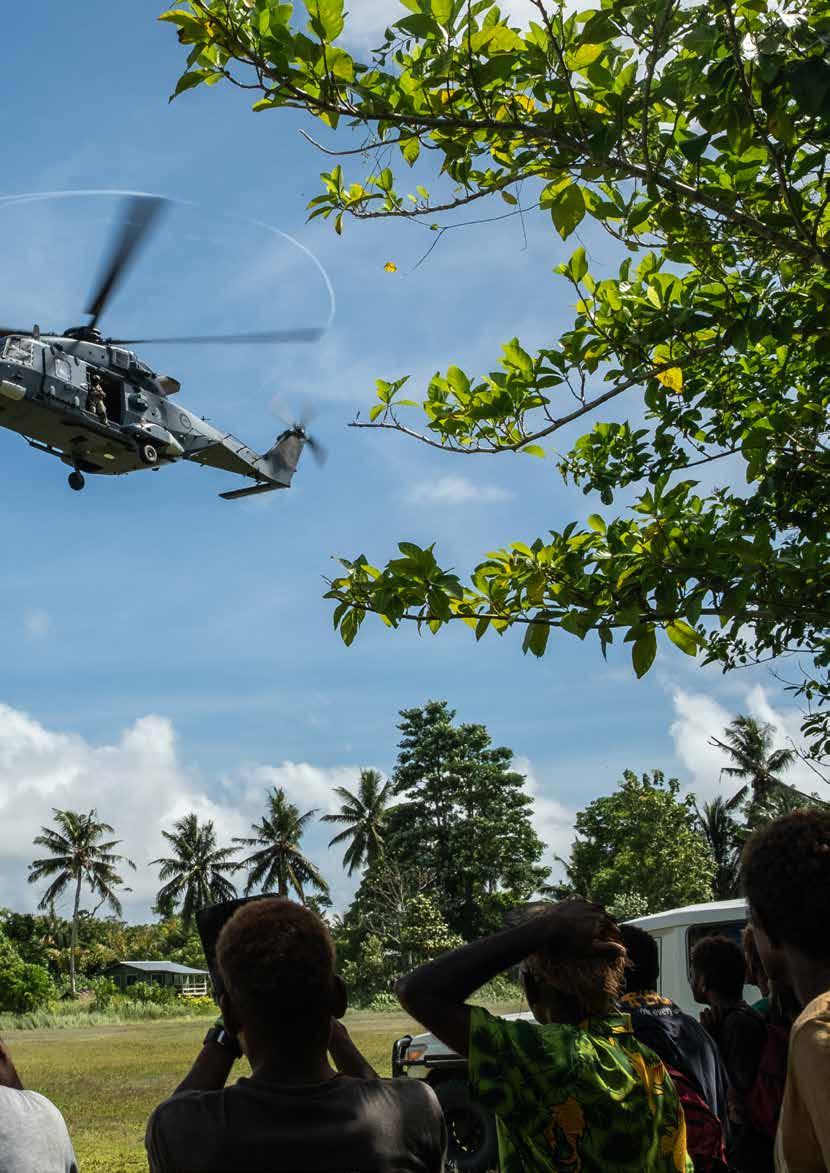

The Royal New Zealand Navy’s HMNZS Canterbury carried two No. 3 Squadron NH90 helicopters, which were used to assist the Solomon Islands’ Electoral Commission to transport polling boxes and election officials to various locations.
Solomon Islands is geographically dispersed, which means it can be logistically challenging to ensure everyone had a chance to vote in the April 17 ballot.
Over the course of 12 days, the Task Force delivered 105 polling kits and 361 ballot boxes, and visited 43 villages throughout Solomon Islands.
The team’s work wrapped up when ballot boxes were collected and taken to counting centres.
Solomon Islands comprises six main islands and more than 900 smaller islands covering a total area of nearly 29,000km2, making it a difficult task to ensure everyone could take part in the election.
The two NH90 helicopters, combined with the ability to conduct flying operations from on board HMNZS Canterbury, was invaluable for navigating those logistical challenges.
Squadron Leader (SQNLDR) Dan Garnett was the Joint Task Force’s Chief of Staff and co-ordinated operations from the headquarters.
“We’ve enjoyed working with Solomon Islands Electoral Commission and appreciated this opportunity to support our Pacific neighbours,” he said.

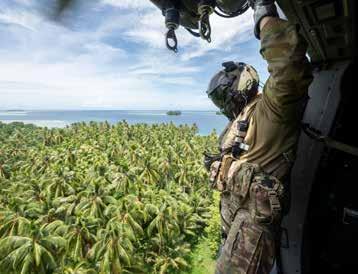
“This was my first time visiting Solomon Islands but it’s great to see the strong ties we have to the nation: from commemorating HMNZS Moa (an RNZN minesweeper, which sank off the coast of Guadalcanal during World War II) to the support offered by the NZDF at last year’s Pacific Games, as well as previous election support.
“Those connections enabled us to get stuck in and get the job done this time as well.”
After the election tasks were complete, the contingent was also able to provide a variety of other support, including delivering nearly 10 tonnes of educational resources and around 240kg of humanitarian aid supplies around the country.
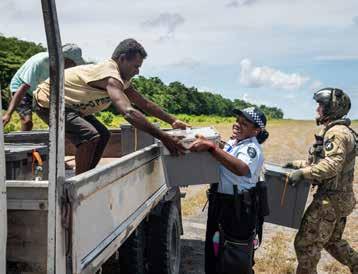

Crews also conducted aerial surveys of landslides on the island of Santa Isabel, which was impacted by the heavy rains of Tropical Cyclone Jasper last year.
The survey data will be used by the National Disaster Management Office and Geological Survey Division to assess the risk of secondary disaster impacts and to mitigate further damage in the affected areas.
SQNLDR Garnett said these deployments are important to show New Zealand playing its role in the Pacific.
“Logistically, it is incredibly challenging, but we have teamed together to ensure everyone in Solomon Islands – even in the most remote villages –had an opportunity to cast their vote.”
– Squadron Leader Dan Garnett
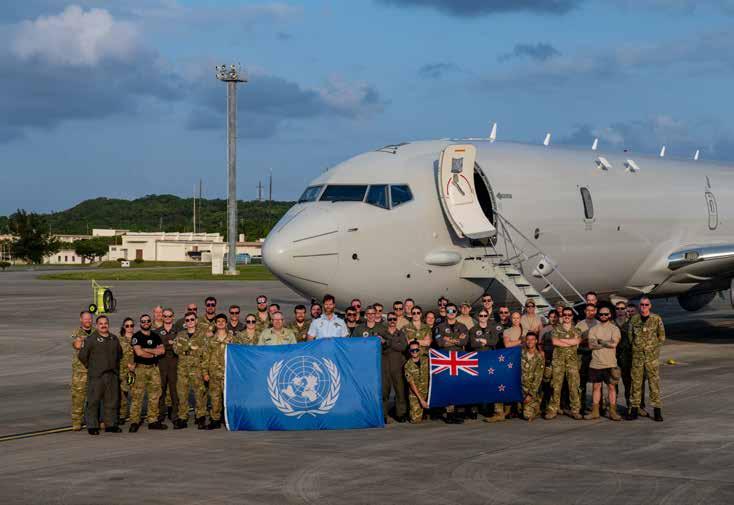
T he New Zealand Defence Force will for the sixth time deploy a maritime patrol aircraft and specialist personnel to detect and deter evasions of United Nations Security Council resolutions imposing sanctions against North Korea.
The Defence Force has contributed personnel and maritime surveillance patrol aircraft to help enforce Security Council sanctions against North Korea since 2018.
North Korea continues to launch ballistic missiles in violation of Security Council resolutions. The sanctions are intended to persuade the country to denuclearise and abandon its ballistic missile weapons capabilities.
Commander Joint Forces New Zealand, Rear Admiral Jim Gilmour, said the Defence Force was committed to working alongside partners on enforcement operations, to uphold the international rules-based system and contribute to regional stability and security.
The maritime surveillance and reconnaissance patrols will be over international waters looking for violations of the sanctions resolutions, including illicit ship-to-ship transfers of banned goods such as oil and coal, he said.
Air Component Commander, Air Commodore Andy Scott, said the deployment included several “firsts” for the Royal New Zealand Air Force’s latest aircraft, the Boeing P-8A Poseidon.
“This is the first time one of our Poseidons has been deployed operationally overseas, the first time we have operated in Asia, which will be the furthest deployment away from New Zealand, and the first time we have used this aircraft in support of New Zealand’s contribution to uphold UN Security Council sanctions enforcement.’’ Previous patrols in support of enforcing Security Council sanctions were conducted by the now-retired “ P-3K2 Orion.
The Poseidon aircraft and crew are based in Japan, conducting sanctions enforcement flights in support of the Enforcement Coordination Centre. Patrols were conducted last month and will continue this month.

The Chief of Air Force Air Vice-Marshal Darryn Webb has welcomed news of the debut flights of NZ7011, the first of the Air Force’s five C-130J-30 fleet. Several test flights have taken place recently, with the first flying from Marietta, Georgia.
The aircraft took to the skies for the first time for 246 minutes over Georgia and Alabama in the United States, reaching 10,500 feet and flying approximately 984 kilometres.
Air Vice-Marshal (AVM) Webb said that the new fleet will take the Air Force’s air mobility capability to the next level.
“The iconic C-130H has been a fantastic aircraft for us for a very long time, across a huge range of tasks and environments.
The C-130J will deliver everything that its predecessor does, and more – it has greater range, speed and capacity.
“It is a proven performer flown by many Air Forces, starting with the Royal Australian Air Force, which will enhance our interoperability with our closest Defence partner.
“These new aircraft take us another step towards honing the modern Air Force as combat-capable, deployable and sustainable. They bring air mobility to the same cutting edge as our new P-8A Poseidon aircraft deliver for air surveillance and maritime patrol, along with our high-performing rotary wing assets.”
The new fleet will also deliver benefits to personnel across much of the Air Force, AVM Webb said.
“We look forward to seeing NZ7011 and the rest of the fleet in New Zealand skies, starting later this year,” he said.
Like their predecessors, the new aircraft will be based at Base Auckland and be operated by No. 40 Squadron.
In 2020 the New Zealand Government signed a $1.5 billion deal for the C-130J fleet. The aircraft have a 40.41m wingspan, are 34.4m long, have a top speed of 330 knots and can carry a maximum of 21 tonnes. They are designed to operate from short or unprepared airstrips.
“The introduction of another modern military capability will enhance career opportunities and development for many of our Air Force team, and help us to achieve the resilience and readiness, which are key goals for us.
– Air Vice-Marshal Darryn Webb
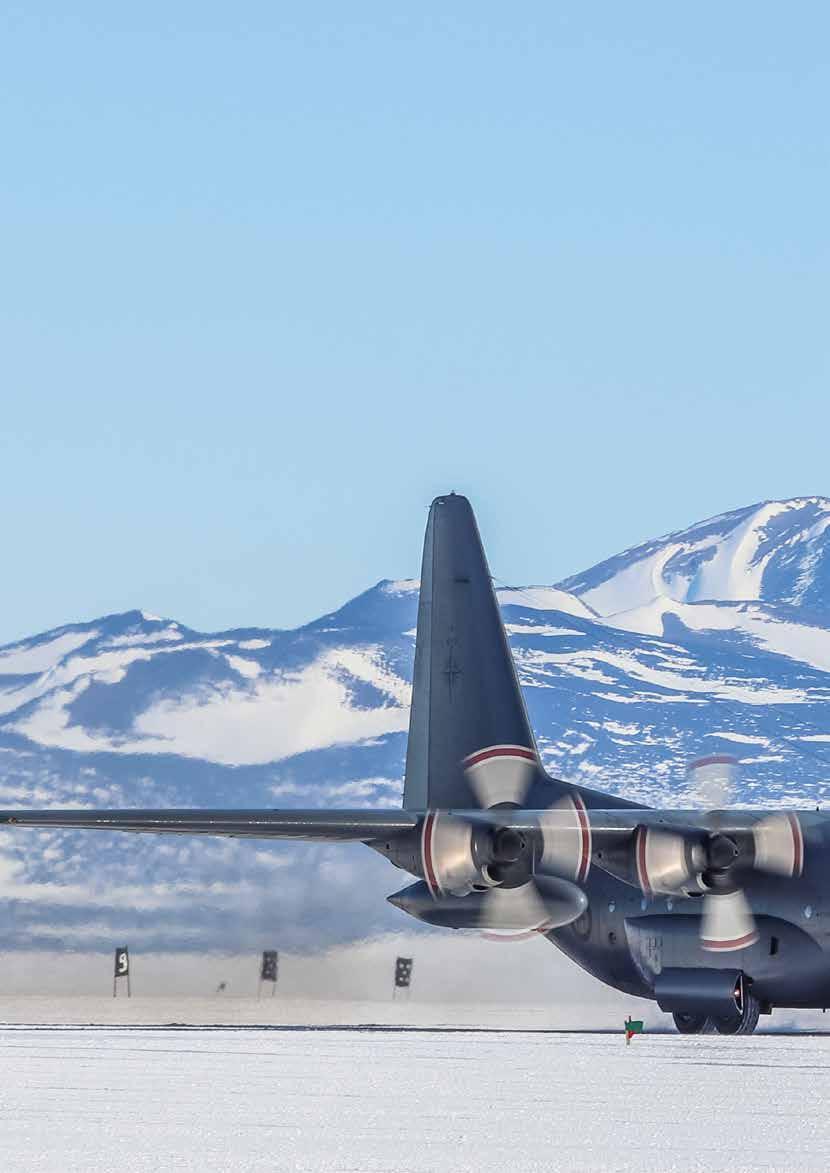
SUE EDEN B Y
PRINCIPAL ADVISOR COMMS
Crew on a C-130 Hercules have conducted a successful medical evacuation (medevac) from Antarctica, a challenging mission given a rapidly closing window of daylight. The flight has also seen the return of the final 12 New Zealand Defence Force personnel deployed to the ice, completing a busy summer season for those on Operation Antarctica.
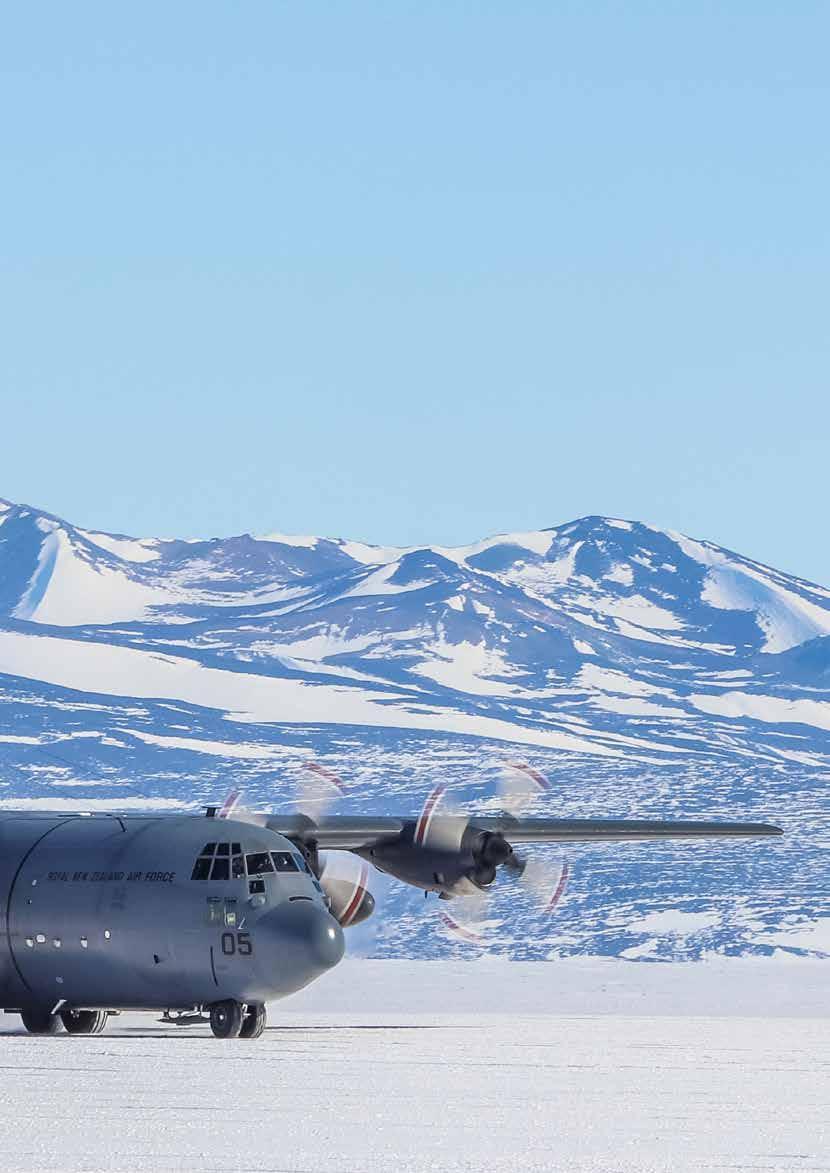
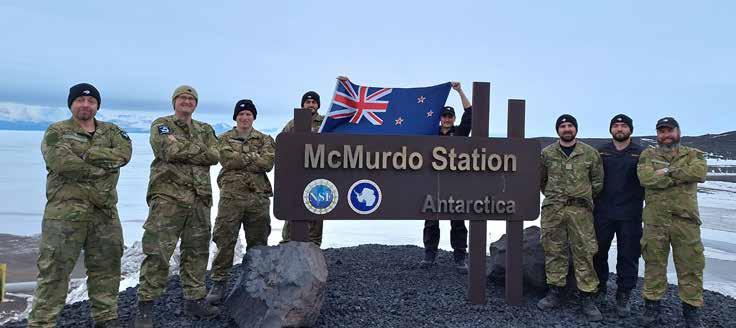

The crew on board the Hercules successfully completed the medevac of an American patient from the US National Science Foundation’s McMurdo Station.
An Air Force doctor and medic were on board the aircraft when it flew to Antarctica’s Phoenix Airfield. On arrival into Christchurch that night the patient was taken by ambulance to hospital.
The return to New Zealand of personnel on the flight marked the end of a season on the ice supporting science and research programmes that are back in strength to pre-pandemic levels.

Defence Force personnel deploy to Antarctica in support of Antarctica New Zealand and as part of the organisation’s contribution to the Joint Logistics Pool (JLP) with the United States Antarctic Programme.
Over the 2023/24 summer season, the Air Force provided 10 C-130 Hercules and five Boeing 757 flights as part of the JLP.
The Defence Force’s contribution also included personnel at Christchurch’s Harewood Terminal, who oversee cargo and passenger movements for all aircraft supporting Antarctica programmes.
This season, the Harewood team supported 141 south and northbound flights with a total of 4197 passengers and 860,000kg of cargo, including fresh food and equipment.
Major Lucy Wright, the Senior National Officer for the Defence Force’s Operation Antarctica, said about 200 personnel were involved over the summer.
This included aircrew on the Air Force’s ice flights and personnel surging in and out depending on their role, she said.
About 70 Defence Force personnel were in Antarctica at the peak, when personnel were deployed to offload and move cargo from ships re-supplying bases in Antarctica.
Their roles varied from drivers, ship offload teams and cargo handlers, to chefs and communications operators who stay in touch with researchers in the field.
“At one point we had teams of researchers and scientists spread over a distance similar to that from Cape Reinga to Bluff. Our communications operators were their link to the outside world.”
– Major Lucy Wright

“It has been a busy season, as the science and research programmes in Antarctica are back to pre-Covid levels,” Major Wright said.
Ship offload teams may be involved in round-the-clock operations when vessels are in port. Depending on their location, a driver might find themselves behind the wheel of a Hägglunds –a tracked vehicle used in Antarctica –while the highlight for a plant operator could be operating a PistenBully snow groomer used on the ice.
The Defence Force regularly deploys a Light Engineering Team involving carpenters, electricians, plumbers, combat engineers and maintenance fitters who maintain and repair facilities.
This season, their work included fitting windows, installing pipes, painting, welding, and installing base plates and stanchions on a section of the fuel line by Scott Base.
Of all those deployed, those serving as members of the Scott Base support team spend the most time on the ice, with stints of around six months.
A deployment to Antarctica includes different experiences from learning to survive in temperatures as low as -40° Celsius to exploring the environment.
“And most importantly, supporting world-leading research and science that impacts us all,” Major Wright said.
As one season closes, planning has already begun for next season’s Operation Antarctica.
NZDF personnel support operations at New Zealand’s Scott Base and also the United States’ NSF McMurdo Station LEFT BOTTOM
Driving a PistenBully (snow groomer) is among the highlights of an Op Antarctica deployment for NZDF personnel like Lance Corporal Kieran Cropp LEFT MIDDLE
An RNZAF Boeing with United States aircraft on Phoenix airfield RIGHT
A C-130 Hercules flew to Antarctica for a medical evacuation of a patient from NSF McMurdo Station to Christchurch, and to transport passengers back from Antarctica

Southern landscapes have provided crucial training grounds for the Air Force during a nine-day air drop exercise aimed at honing skills for the real thing.
AC-130 Hercules from No.40 Squadron was a regular sight in Central Otago and Lake Districts skies recently as the New Zealand Defence Force carried out Exercise Skytrain, focussing on tactical low-level flying and delivering and picking up loads in scenarios where areas could be under threat.
The flying techniques practised are essential in keeping Air Force aircrews’ flying currency up-to-date, as well as the skills used on deployed operations.
The Hercules and personnel from Bases Auckland, Ohakea and Woodbourne deployed to Wānaka Airport, alongside personnel from the New Zealand Army.
Air Force ground trades, including security forces, air movements, aircraft and safety and surface technicians, Rescue Fire Service, aviation fuel, logistics, intelligence and communication and information systems specialists, were all involved.
“An important part of our training is being able to operate effectively and successfully away from our home base,” said Detachment Commander, Wing Commander (WGCDR) Brad Scott.
“So every year we run a Skytrain exercise in New Zealand to test and build our deployment resilience.
“It exercises our entire deployed system, including our support elements, which are critical for airborne operations,” he said.
The training and experience achieved through this exercise were directly relatable to real-world scenarios, WGCDR Scott said.

“This is to support such things as the Cyclone Gabrielle response or deployment on US Air Force-led Operation Christmas Drop out of Guam, where we deliver pallet loads of goods via a C-130 to people living on remote islands and atolls in the Pacific,” he said.
Exercise Skytrain encompassed much of Central Otago and into the Mackenzie Country, with some flying sorties going as far afield as Hokitika, Timaru and Invercargill.
Air drop sorties were focussed on three drop zones in the Ida Valley and Maniatoto Valley near Ranfurly. Other missions saw the aircraft land and load or unload personnel or equipment with engines running.


“The terrain around Wānaka is irreplaceable for low-level flying techniques and it’s great to exercise there and engage with the local community while supporting local businesses.”
Wing Commander Brad Scott
LEFT
Pallets dropped from the back of a C-130 Hercues
TOP RIGHT
An air loadmaster during the exercise
BOTTOM RIGHT
A C-130 Hercules refuelling
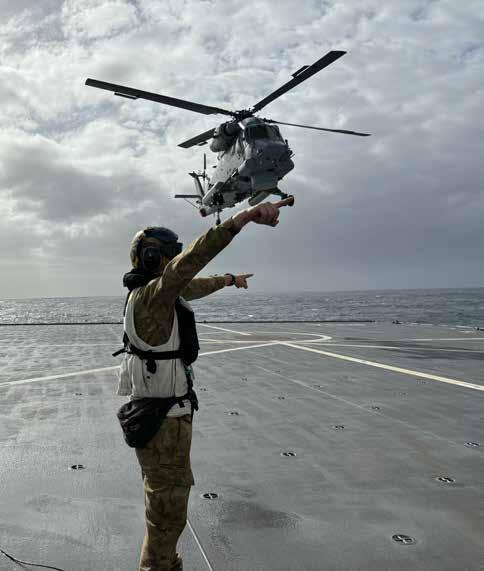
Deliberately seeking out challenging weather to land a helicopter on a ship’s flight deck seems like a bad idea, but it’s exactly what Seasprite SH2-G(I) aircrews needed for HMNZS
Aotearoa’s First of Class flight trials.
“Luckily we had a whole mix of weather - we had some quite strong winds, which was pretty good. We also found some goodsized swells north of the North Island that gave the ship a bit of movement,” Training Flight Commander Lieutenant Commander (LTCDR) Matt Snazell said.
The ship’s information officer Ensign Emma Walker agreed.
“We were lucky with the weather. We didn’t have to search too hard for rough seas and high winds.”
Aotearoa recently passed its First of Class flight trials in partnership with No. 6 Squadron for Seasprite SH2-G(I) helicopters to operate from its flight deck.
Every class of ship capable of embarking and operating a helicopter needs to conduct trials to ascertain Ship Helicopter Operating Limits – the safe limitations for a specific helicopter type flying to and from that particular class of ship.
The trials experimented with wind direction, ship movement and weight parameters for launching and recovering that helicopter, day and night.
LTCDR Snazell said the difficulty with the ship moving was working out where the waves were coming from.
“Aotearoa is such a big ship it’s quite difficult to tell. You see the swell break over the bow of the ship, but then it takes few seconds for it to get to the flight deck at the very end. You’re really just having to sit and wait for the opportune moment.”
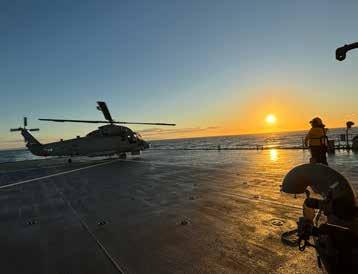
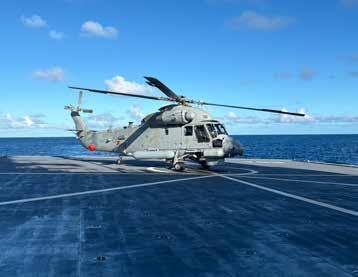
The ship’s company and the flight crews also have to learn how the wind behaves in relation to the superstructure of the ship and its course and speed, which could alter wind direction and speed over the flight deck. There’s also the ship’s roll and pitch to take into account, depending on how the ship is pointing into the relative swell.
“We did spend quite a lot of time going up and down with the ship and it looked quite hectic from the flight deck as it looked like we were moving all over the place,” LTCDR Snazell said.
The training enabled the helicopter crews to look for the “edge of the night flying capability” – and they found it.
“We had a few issues with really strong winds and turbulance coming over, so we worked out there were certain areas we couldn’t use. We can’t have winds from a certain direction or at a certain strength.
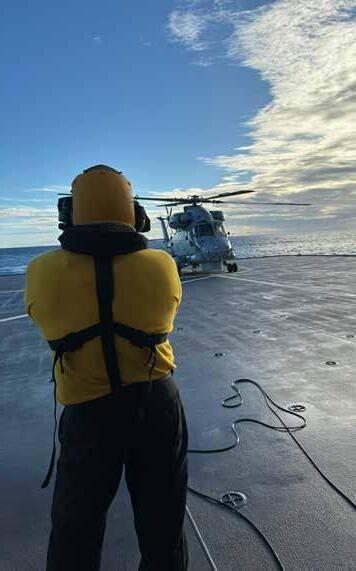
“Strong winds from a really tricky direction means it’s not safe to operate the helicopter, so that’s where we drew the line,” LTCDR Snazell said.
The crew used a combination of night vision goggles and flying unaided, using the lights from the ship.
Both the ship and Seasprite were fitted with precision instrumentation to correlate relative wind speed and direction with the helicopter’s performance. Readings of engine thrust, rotor torque, landing force and other parameters were taken into account.
The more variable and challenging the weather, the more complete the data gathered would be. Cruising around the calm Hauraki Gulf wasn’t going to be enough.
Commander Rob Welford, Commanding Officer Aotearoa, said the trials took nine days.
“Finding the operating limits required the ship to seek out bad weather and this was achieved with the help of an embarked meteorologist. A large swell was encountered near Cape Reinga, and strong winds off the East Cape.”
“The biggest waves were eight metres high, our largest roll was nine degrees and largest pitch was 5.7 degrees.”
The trials required nearly 28 hours of flying, 181 deck landings plus 41 other trials such as transfer simulations and refuelling.
“It’s also a very good test of the ship’s organisation and ability to coordinate flying operations in all variations of weather and sea states.”

The Air Force embraced its history and future at this year’s Warbirds Over Wanaka, with the air show being the final southern public outing for the retiring C-130H Hercules aircraft.
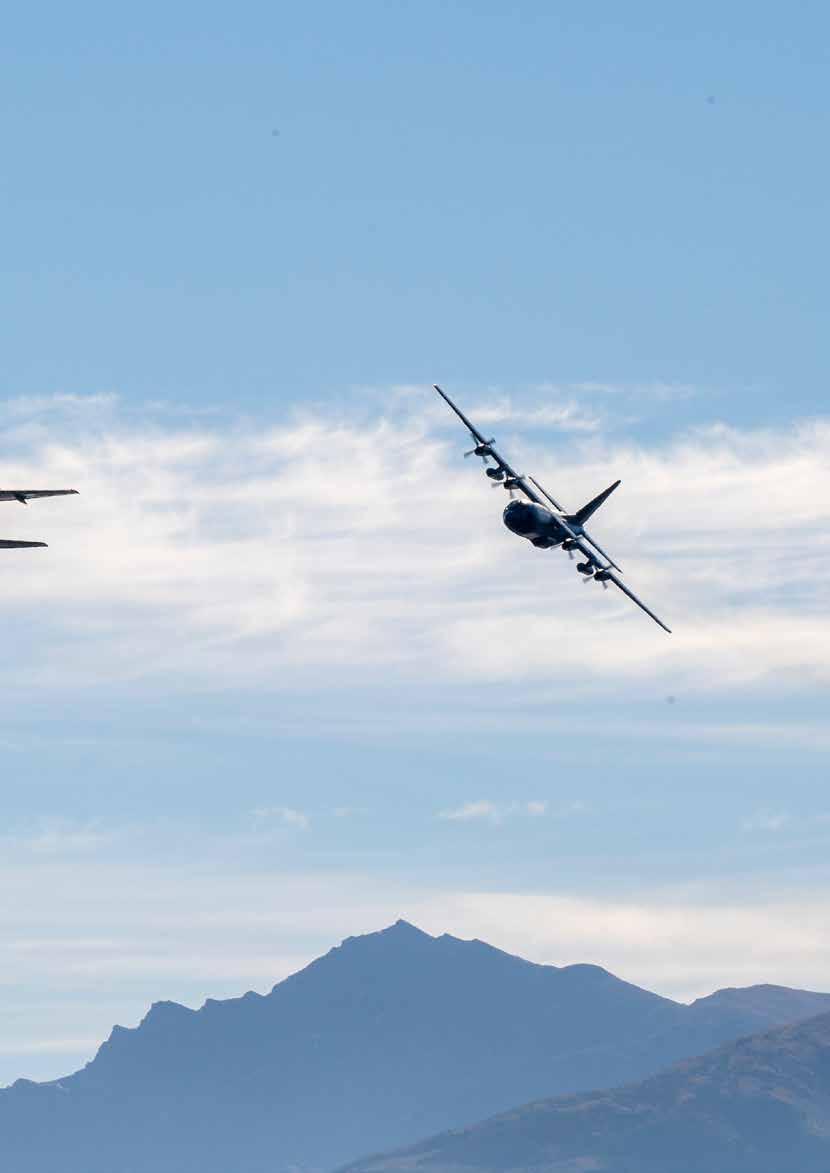
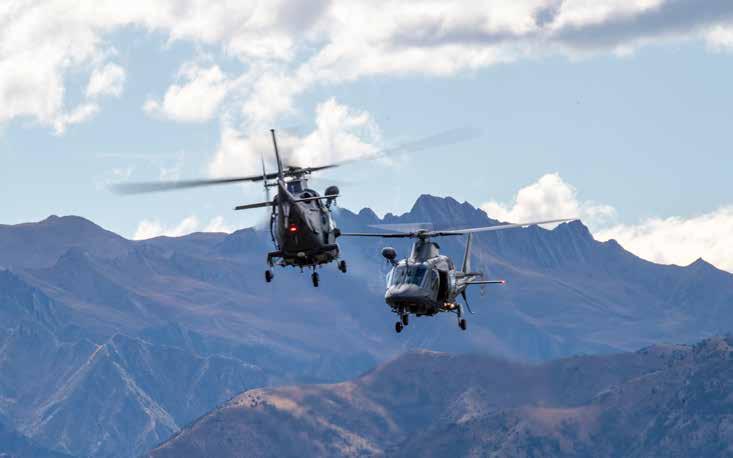
Every current Air Force aircraft type made an appearance at the event either in a flying or static display.
The Air Force Heritage Flight also wowed the public, including a recently restored P-51 Mustang in its first public flying display.
The newest in the service’s fleet, a P-8A Poseidon was seen in display action for the first time, demonstrating a simulated raft drop with a low pass down the airfield. It was the final air show for the retiring fleet of No. 40 Squadron C-130H Hercules, and they celebrated the iconic aircraft with a Formation Thunder flypast, a handling display, Kiwi Blue parachute display and a spectacular lakefront flare drop.
“Events such as Warbirds Over Wanaka provide an opportunity for the Air Force to display its aircraft capability, showing how it can support the people of New Zealand,” said Chief of Air Force, Air Vice-Marshal Darryn Webb.
“Domestic air shows and display activities enable the Air Force to inspire, educate and engage with the communities it serves. Not only do they allow for the demonstration of our skills and capabilities, they also support the preservation of the Air Force’s history.”
Flying in the skies above Wānaka was a special experience for C-130 Hercules co-pilot Flight Lieutenant Angus Knox, who grew up in Dunedin and spent every holiday at the lakeside Central Otago town.
Fellow C-130 Hercules co-pilot Flight
Lieutenant Ben Pickering said it was a bittersweet feeling to co-pilot the aircraft with the fleet to be retired early next year.
“I’m very excited to be involved with Warbirds, it’s an incredible privilege to play a part in the last display for the Hercules.
“The aircraft have so much history, they are proper Warbirds. It’s cool to be part of its history before moving onto the new C-130J fleet,” he said.
Flying at the air show was a big deal for helicopter pilot Flying Officer (FGOFF) Callum McNally, who took to the skies in an A109 aircraft.
“Warbirds was my first big event with No. 3 Squadron. I’m pretty lucky to have had the opportunity to take on a display like that so early in my career,” he said. FGOFF McNally flew an A109 in a two-ship handling display before teaming up with a SH-2G (I) Seasprite and NH90 helicopters for a combined winch display.
“The synchronised display is essentially two helicopters moving simultaneously. The A109 is really manoeuvrable, it’s great for learning on and from a training perspective it’s fantastic, it’s got everything we need.”
Squadron Leader Jim Rankin is the Air Force Air Display Director and has been to every Warbirds event bar one, as both the military Display Director and civil Display Director.
“Whenever an aircraft gets airborne, it requires more than just our aircrew to operate them – it requires technical staff to maintain the airframes, working alongside logisticians, refuellers, security forces and firefighters. Everyone has a part to play in delivering our military air operations.”

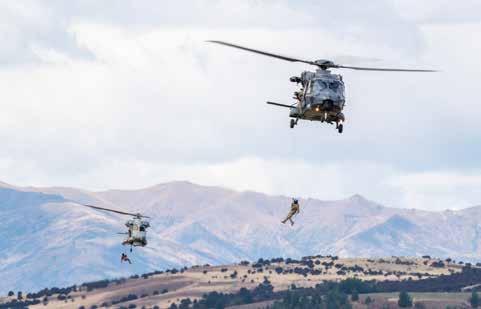


“There’s heaps of camaraderie with the crew and it’s really special to be a part of history with the aircraft type, and it’s a privilege to stay until the end of an era.”
– Flight Lieutenant Angus Knox
WORDS | ANDREW BONALLACK
PHOTOS | CPL NAOMI JAMES

Base Ohakea’s No. 3 Squadron’s work in Solomon Islands last year has earned them medallic recognition.

Nearly 100 medals have been awarded by Air Component Commander Air Commodore Andy Scott to personnel of No. 3 Squadron for their support to Solomon Islands during the 2023 Pacific Games.
A rotary wing task unit (RWTU), flying two NH90 helicopters, was part of a joint Australian, Fijian, New Zealand and Papua New Guinea task force assisting the Royal Solomon Islands Police Force with security duties during the Games in Honiara during November.
The task unit flew a total of 66 hours during 45 flights, providing medical and logistics tasking.
The deployment also gave crews the opportunity to practise integration and flight deck training with the United States Navy’s USNS Mercy; a 1000-bed hospital ship providing medical support to the Solomon Islands.
At a recent medal ceremony personnel received the New Zealand Operational Service Medal and the New Zealand General Service Medal 2002 (Solomon Islands).
The latter medal is awarded for service in Solomon Islands towards the maintenance of stability and resilience of the country. The most recent criteria is service since December 2021, following the riots of November 2021.
The last time a No. 3 Squadron deployment qualified for medallic recognition was in 2008, when deployed personnel received the New Zealand General Service Medal 2002 (TimorLeste). On that deployment, No. 3 Squadron served in Timor-Leste from April 2006 to October 2008.
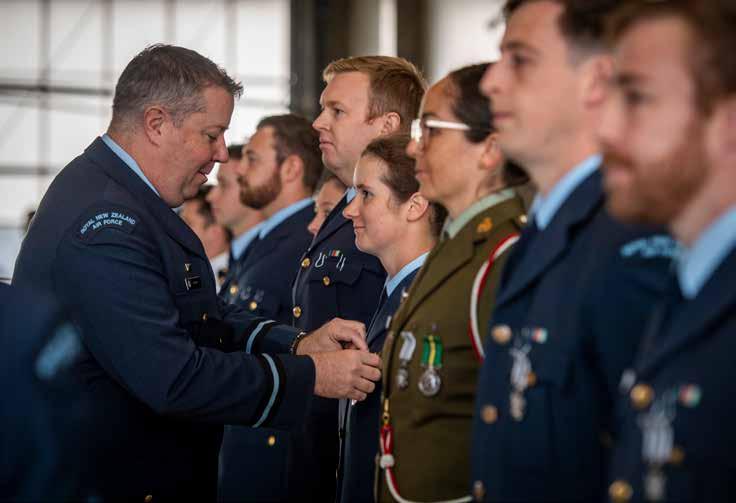
Flight Lieutenant Liam Barrack, who was on the recent Solomon Islands deployment, says they were dealing with many different organisations and officials of multiple backgrounds. Tasks ranged from familiarisation flights with Australian Defence Force personnel to transporting medical personnel to outer islands.
“In other situations our choppers might have been integrated as part of an Australian RWTU, but given the Australians are no longer operating their MRH-90s, it was just us.
“We had a pretty diverse range of Air Force trades represented too, all part of the system that gets the job done. Aircraft technicians, avionics technicians, Communications and Information Systems technicians, logistics personnel, pilots, helicopter loadmasters, aviation fuel specialists, intelligence personnel, Security Forces personnel and their Military Working Dogs; all with their part to play.”
One of the highlights was working closely with the Australian Army, he said.
“The chance to integrate with a bigger military was great to experience. We see their attitude, we live in the same space, share meals, beat them at volleyball, and get to see how they operate.
“It was also great to visit the USNS Mercy and share stories and swap patches with American sailors, while also conducting some really valuable aero-medical evacuation training for the ship and our flight crews.
“These deployments allow us to see different militaries, different cultures, all at work to achieve the same goal.”
“We were there primarily to provide a contingency force for any shortnotice security tasks, and what we achieved ensured our partnership with Solomon Islands remained strong,”
– Flight Lieutenant Liam Barrack

When Aircraftman Georgia Woodhouse recently graduated at Base Woodbourne, she officially joined what her mum calls the “family business”.
With her brother a recruit last year and her mum and dad ex-Air Force, serving from the late 80s, it’s a path her family knows well.
Aircraftman (AC) Woodhouse previously worked a 9-5 job at a Blenheim winery, living with her cat and making ceramics that she sold at the local market, but knew it wasn’t her calling.
Joining as an Air Warfare Specialist, she has spent the past three months at Base Woodbourne with 60 other new recruits learning all the skills necessary to become an aviator.
It was a “complete 180° shift in lifestyle”, AC Woodhouse said.
“Right from day dot it was very strict. A huge change from civilian life,” she said.
Even with a strong family connection, she wanted to go in fresh and keep some things in the course a surprise, like what happens during the week at the Dip Flat training ground at the top of the Wairau Valley.
This is where recruits put into practice all the skills they have learnt in a dynamic military environment. From night time patrols, quick fire responses and vehicle searches, the recruits are put through a range of real-world scenarios to test their knowledge.
“Dip Flat is definitely a highlight of the course. I’m quite an outdoorsy person so it’s nice to get out of the classroom environment and into the action. I have also learnt a lot about backing myself. It would have been really easy to sit back during the training but they make sure you are confident in participating.”
It wasn’t a straight path to the Air Force for AC Woodhouse as she was on “no set route” once finishing high school.
“It was really my brother who piqued my interest in the Defence Force. I applied without telling my parents, and eventually told them when I got accepted.
“My parents didn’t push me into the Air Force - they believe the Air Force should only have people who really want to be there.”
She will now complete specific trade training at Woodbourne before moving to Base Ohakea later this year.
As an Air Warfare Specialist, AC Woodhouse will fly on the P-8A Poseidon, processing and analysing information to support a range of surveillance flights.
“I’m really interested in helping out in the Humanitarian Assistance and Disaster Response work the Defence Force does,” she said.
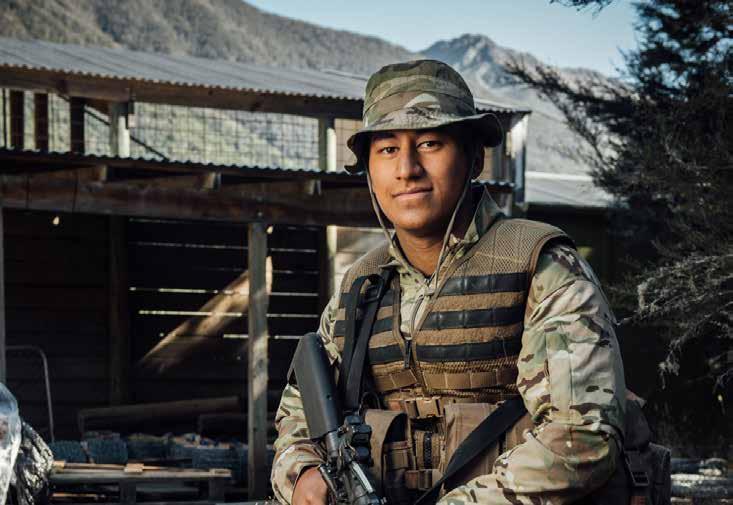
Aircraftman Kaliomiha Talamahina is the youngest of 61 graduates from his recruit course and says the youthful starting point gave him the drive to succeed.
Growing up in Niue, Aircraftman (AC) Talamahina’s family moved to New Zealand six years ago, where they live in Avondale, Auckland.
The 17-year-old has five younger siblings and he found the tables were turned on him during the course.
“Other people here have more life experience than me so I want to show everyone I am mature and responsible. They are there for me to learn from. I ask questions and they help guide me.”
Having the strong network of people around him helped him through the more stressful times of recruit training.
His father served in the New Zealand Army as a gunner, also signing up as a 17-year-old.
AC Talamahina said growing up in a military household helped him adapt more easily to life as a recruit.
“All the lessons my dad has given me in life are similar to what I am learning in the Air Force. He doesn’t talk too much about his time in the Army, but I can start to see why he is the way that he is,” he said.
Looking back on the three-month training course, AC Talamahina said he loved the hands-on learning and wide range of experiences he has had – including weapons training, field survival skills and physical fitness training.
“My dad doesn’t show a lot of emotion but I know he is proud of me,” he said.
Now graduated, AC Talamahina has started his primary trade training with Security Forces – a role which will see him protecting Air Force personnel and equipment against a range of threats.
Outside of his trade, he is also interested in playing sport.
“I have grown up playing rugby and basketball and played on high school and rep teams and would like the chance to represent the New Zealand Defence Force.”
“There was lot to learn while we were there, and there was a lot of attention to detail. You needed to be ready to go whenever they call on you.”
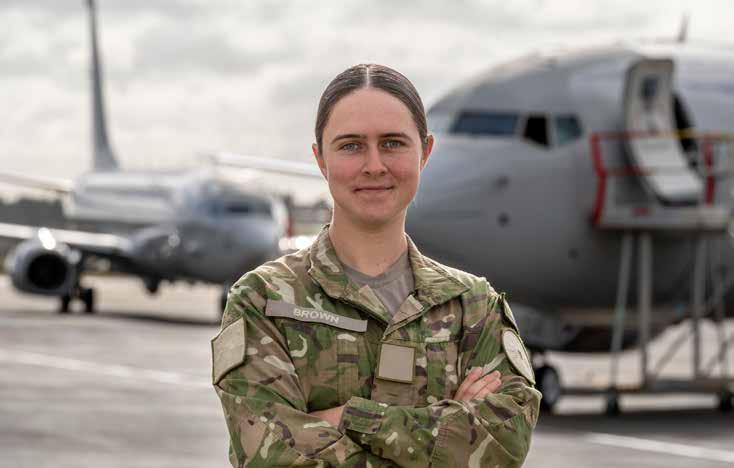
Communications mechanic Leela Brown was happy to “pass it forward” after travelling to her home region to promote the technology side of the Air Force.
Aircraftman (AC) Brown was part of a roadshow that travelled to Northland schools to run interactive Science Technology Engineering and Maths (STEM) activities for students. The team taught basic theory of flight to foster interest in aviation STEM.
It was the first time they had gone to Northland, with visits to schools in Kawakawa, Kerikeri and Kaikohe.
AC Brown comes from even further north at Taipa, Doubtless Bay, where she attended Mangonui Primary and Kaitaia College.
At 18 she joined the Air Force as a Communication and Information Systems Mechanic.
“I had been thinking about joining the Air Force all through high school,” she said.
“I got the opportunity to be part of a School to Skies wāhine camp, spending a week at Base Auckland. I’ve experienced first-hand how helpful the School to Skies programme can be for students.”
School to Skies is a technology and aviation camp open to females in Year 13 who are engaged in STEM studies.
“I was unsure about study at university and joining the Air Force gave me the opportunity to get paid to learn, as well as the option to pick up study in the future funded through Defence.
“My experience on School to Skies further confirmed that the Air Force was something that I wanted to pursue.”
As well as running roadshow activities, AC Brown talked about her own experiences of the Air Force and her pathway from school in Kaitaia to joining.
Students were likely to relate to her biggest worry at that time – being so far away from family.
“When you’re from the Far North, getting home to visit does provide some challenges.
“However, you make it work and there are various things provided by Defence that help, including travel warrants and military flights provided on some weekends.”
What she enjoys the most about the Air Force is the people.
“I have been so fortunate to meet and make so many friends. The Defence Force really does become your family.
“Another thing that is great about being in the Air Force is all the clubs and activities that you can be a part of outside of your trade.”
Her advice to Year 13 students would be to go for it.
“Just make the leap. It may be scary to start with but everything will fall into place.”
“It was a chance for me to pass it forward, to go back home and help open students’ eyes to the options available, as was once done for me.”
BY LEAD CONTENT EDITOR ANDREW BONALLACK
Core values are not just for a school or the military – they’re meant to exist in everyday life.
That was the messaging for pupils of Renwick School in Marlborough, who recently welcomed about 60 Air Force recruits for activities and classroom discussion.
Renwick School’s vision statement is Learning is Strength - Be the Best You Can Be. It underpins their values’: Respect, Resilience and Integrity.
Aircraftman (AC) Jay Challenger says the visit allowed them to show the pupils how similar the Air Force core values –courage, commitment, comradeship and integrity – were to theirs.
They worked with the students on a series of outdoor challenges and obstacles, ranging from tightrope walking, an obstacle course, stretcher carries and a physical training circuit.
“We realised how much they looked up to and trusted us simply because of the uniform we wear. Without a second thought they would trust someone they had only just met to spot them around obstacles, stop them from falling, and carry them,” AC Challenger said.

“It demonstrated how much trust and faith even the youngest of our generation, and all civilians place in us and how important it is for us to maintain their trust so we can do our job effectively with their support.”
After the obstacle course session, the trainees engaged in classroom discussion about the school’s values and a question and answer session about the Air Force.
AC Jalesa Nomani says the children were eager for knowledge.
“They asked some very good questions about the school values and how we demonstrate those in our day-to-day lives as well as at work. Their values are very similar to ours so we had plenty to chat about.
“We talked about showing respect to our superiors and comrades, demonstrating resilience by getting up at 5.30am and ironing our bed even though none of us wants to, and resourcefulness by making do with what we have and sharing with our course-mates, like using a busted iron or swapping ration packs with your mates so everyone gets the food they like when on exercise.”
School principal Michelle Spencer says the trainees arrived just as the pupils were being positioned at the obstacle course stations.
“The timing of the group was impeccable, presenting themselves in a well-drilled formation, as they marched onto the school grounds. The students acknowledged straightaway the respect, resilience and resourcefulness from the Air Force cadets, which created an immediate trust between the two groups.
“It’s not just words to them. This is how they work, and what they do, how they wear the uniform, and how they respect each other and acknowledge each other. It showed the pupils that the values don’t just sit with Renwick School – they exist elsewhere.”
The recruits’ day also included helping the Marlborough RSA with cleaning their 750 white memorial crosses in preparation for Anzac Day.
AC Challenger says it was a humbling experience, as the crosses had a lot of detail about those who had given their lives in service to their country.
“Most of them were under 25, which hit close to home for a lot of us. Each of those crosses signified a real life sacrifice. In another time it could have been one of us.”

The Air Force Museum of New Zealand’s P-3K2
Orion proved to be a huge drawcard in retirement with the public turning up in droves for a rare chance to see the aircraft up close.
More than 9000 people turned up over four days in April to see the newly reassembled NZ4203 in its new home in the historic No. 3 Hangar in Christchurch.
Deputy Chief of Air Force Air Commodore (AIRCDRE) DJ Hunt was on hand to officially launch a new exhibition about the Orion.
AIRCDRE Hunt, who has NZ4203 in his logbook from his time on No. 5 Squadron, said there was no doubt it was an extraordinary aircraft and he had fond memories of many sorties aboard Orions. The four open days were held to give the public the chance to get close to NZ4203 before it goes into long-term storage.
The Orion is too large for the museum’s current exhibition spaces, so it is being carefully conserved and stored until a new space is developed to house it and a retired C-130H, which has also been earmarked for conservation.
Air Force Museum of New Zealand Director Brett Marshall said the open days drew record crowds, which confirmed the Orion’s star power.
“There’s nothing like seeing an aircraft like the Orion up close so we were really pleased that so many people took the time to come along. We had fantastic support from our local Air Cadets and volunteers to handle the crowds, which exceeded our expectations.
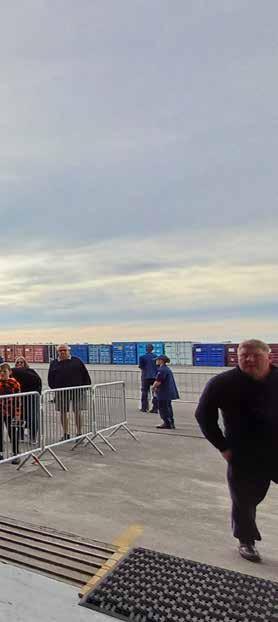
“NZ4203 is in beautiful condition and is a testament to the men and women who maintained and operated the aircraft for so many years.
“People love hearing the stories about the Orion – and we had a steady number of P-3 people through with great stories to tell.”
The P-3K2 was dissembled for an epic 455km road trip last year before being reassembled and prepared for longterm conservation at the museum in Christchurch.
“We knew it was going to be popular –but we had no idea just how popular.”


NZ4203 was delivered in 1966 and is the only Orion in the RNZAF’s fleet of six to be conserved. It flew 27,000 hours in its 54-year career and performed extraordinary service for the RNZAF and for New Zealand.
The museum has developed an ongoing exhibition in its Cochrane Gallery to celebrate the aircraft.
Called P-3: The story of an extraordinary aircraft, the exhibition’s centrepiece is a wooden scale model of the Orion built at Hobsonville in 1968.
A documentary about the aircraft featuring interviews with past and present Air Force personnel, as well as yachtie Murray O’Neil who was rescued by the Orion, is also part of the exhibition.
The museum has also developed a line of P-3K2 Orion merchandise – including caps, t-shirts, pencil sharpeners and wooden models.


Life on the NH90 happens in “swings and roundabouts”, or so I’ve been told. A “framey” (aircraft technician) can find themselves in the most bizarre of situations, followed by a swift backhander of adrenalin ending in a cold one on the mezzanine floor after a long week.
Our recent trip to Solomon Islands, in support of the Pacific Games, is a fine example. A lot of last minute changes and planning sent us hauling along in a C-130 Hercules to the unfamiliar island group with little to no idea what to expect of our accommodation or taskings. Oh well, it was an adventure.
The following weeks had us smashing out aircraft rebuilds, defect rectification, servicings and aircraft tear-downs, not to mention a fair amount of “friendly” sports with the Australian Defence Force, who shared our accommodation. But that’s all fairly normal for our job. What made it exciting and challenging was doing it outside the comfort of our cosy hangar back home.
Time to paint a picture. Imagine an old tired clam shell hangar propped up on some shipping containers in an equally sad state. The hangar lies just a short distance from the only runway at Honiara International Airport.
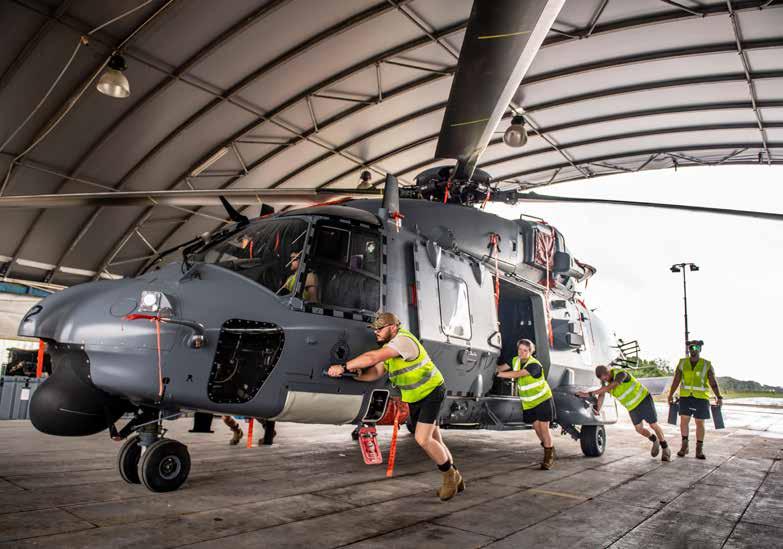
Within earshot of the hangar is an overgrown chain link fence through which we can see the locals doing the day’s washing behind their homes and kids scrambling about the trees to get a better look at us.
The grounds are littered with dishevelled buildings and abandoned machinery, including the corpse of a Boeing 737. It’s raining. Take the worst rain you’ve ever seen in New Zealand, double it and make it warm.
Working just outside the hangar is a team of aircraft technicians fitting blades to the first NH90. Some are covered head to toe in wet weathers, hoping to keep the rain out of their boots. Others have given up all together on staying dry and although the rain permeates everything it feels good to have the sweat rinsed away.
Like clockwork the team works to hook the blades up to the spider crane, manoeuvre into position and secure to the blade grips.
“We carried out these complex tasks in near 100% humidity, 30+ degree days and cyclone levels of wind, rain and thunder. We had to work as a proper team to find solutions to problems we had never come across and make decisions that would have real consequences for the operation.”
It’s a task made difficult when the rain pelts your eyeballs every time you look up. Meanwhile those with glasses struggle with constant fogging and a lack of window wipers.
But everything is awesome. The blades go on in almost record time and we damn near cause an injury patting ourselves on the back before returning to camp for a well-earned ration pack.
Not every day working on the NH90 ends in success but we can always be proud of the effort we put in.

A reunion for past and current serving Communications staff is to be held in Palmerston North and Base Ohakea on September 25 and 26, 2024.
Those of you who served pre-2003 in the former RNZAF Telecommunications Branch trade musterings of Telephone Operator, Comm Asst, Teleg, COM OPR/ TC/STC OPR, or post-2003 as CISMECH or CISTECH in the Communication and Information Systems (CIS) trade are invited to request event and registration information.
Send an email to Q85988@gmail.com with ‘Please send me Information’ in the subject line.
Two RNZAF trade names changed on April 1, 2024.
Firefighter (FIRE) became Aviation Rescue Firefighter (ARFF)
“Aviation Rescue Firefighter” more accurately reflects the primary role of the trade and aligns with other military and industry partners who deliver similar outputs at military and civilian airfields.
Supply Officer (SUP) became Logistics Officer (LOGO)
“Logistics Officer” more accurately reflects the wide range of trade outputs delivered by these Officers. It is a term that is more meaningful for direct entrant recruitment candidates, and aligns with the Logistics Specialist trade and with foreign military trades.
AGM & REUNION
RNZAF Base Ohakea, July 19–24, 2024
Friday
• Registration
• AGM
• Meet and greet
Saturday
• Tours of No. 3 Squadron and Biggin Hill
• Drinks and dinner
Sunday
• Overflow tours
An event in support of part-time personnel and the organisations who support them.
Employer of the Year
Limited Service Volunteers (LSV) Employer Recognition Award
Outstanding Contribution to the the Limited Service Volunteers (LSV Programme
REQUEST NOMINATION FORMS:
secretariat@desc govt.nz
SUBMIT NOMINATIONS:
Through your Chain of Command, include: secretariat@desc govt.nz
CLOSING DATES:
Reservist of the Year: 19 August 2024
All other Categories: 17 May 2024
QUERIES?
secretariat@desc govt.nz
“Up the Wahs!” Special match ball delivery via an Air Force A109 Light Utility Helicopter into Go Media Stadium, Mount Smart. The pilot made a 360° spin prior to landing, which gave a great photo opportunity for the crowds gathered for the Warriors’ Anzac Day match against the Gold Coast Titans.
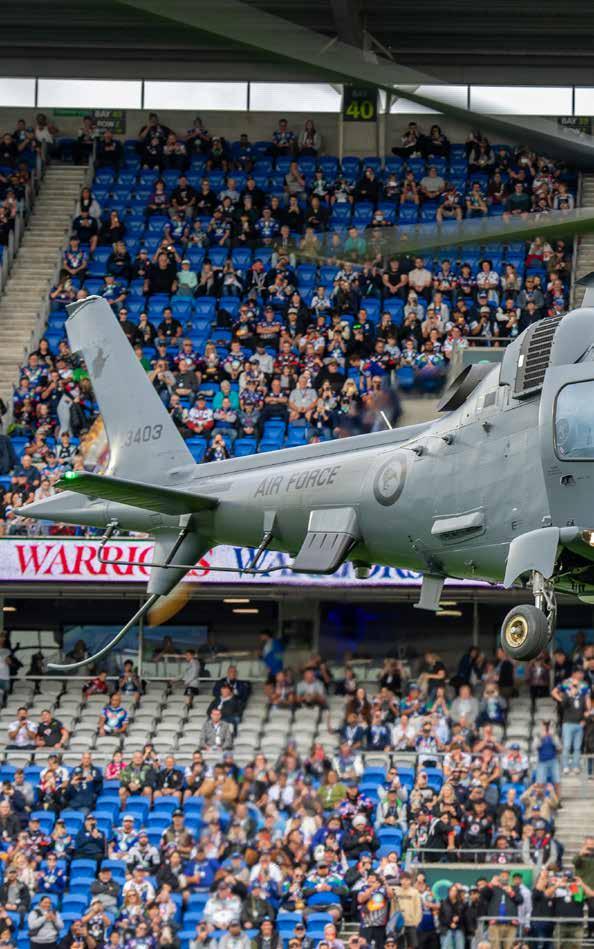

Every day, members of the New Zealand Defence Force achieve extraordinary things.
Listen to season two of Unclassified, wherever you get your podcasts.

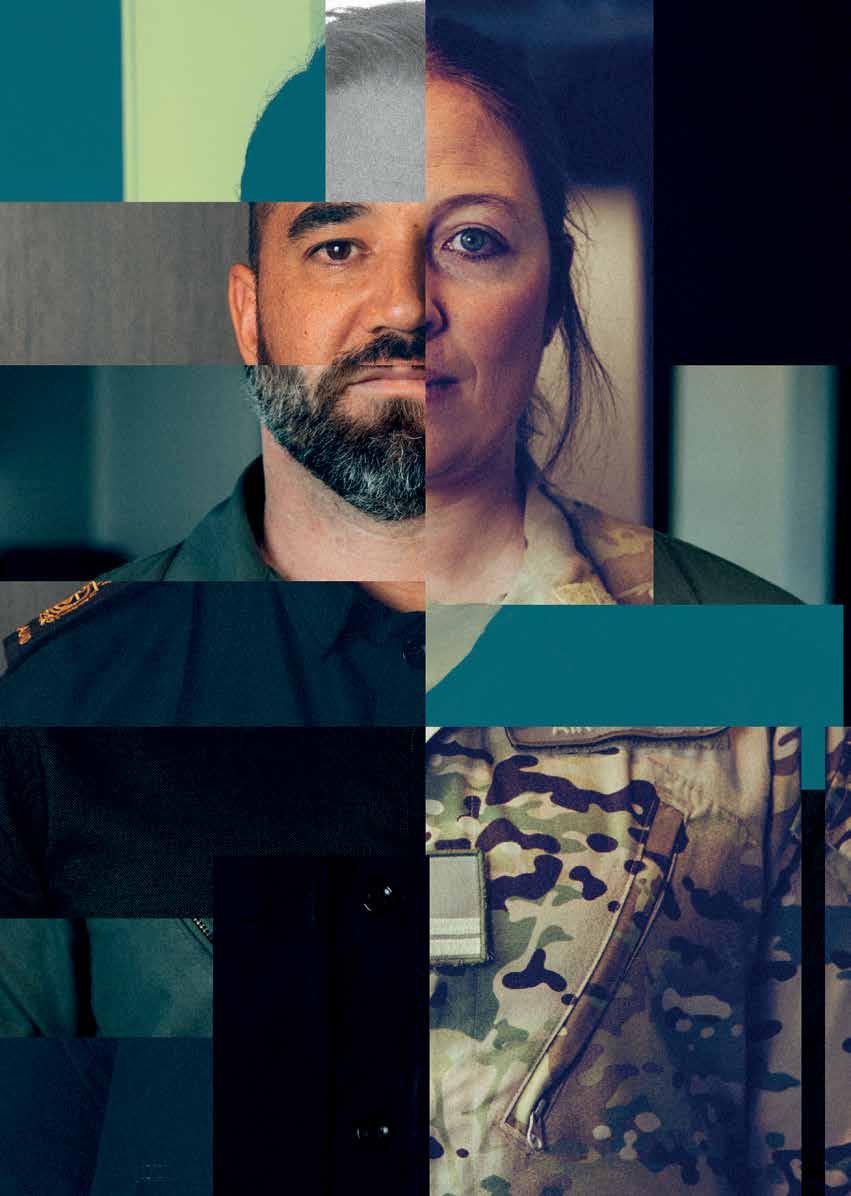
SEASON TWO